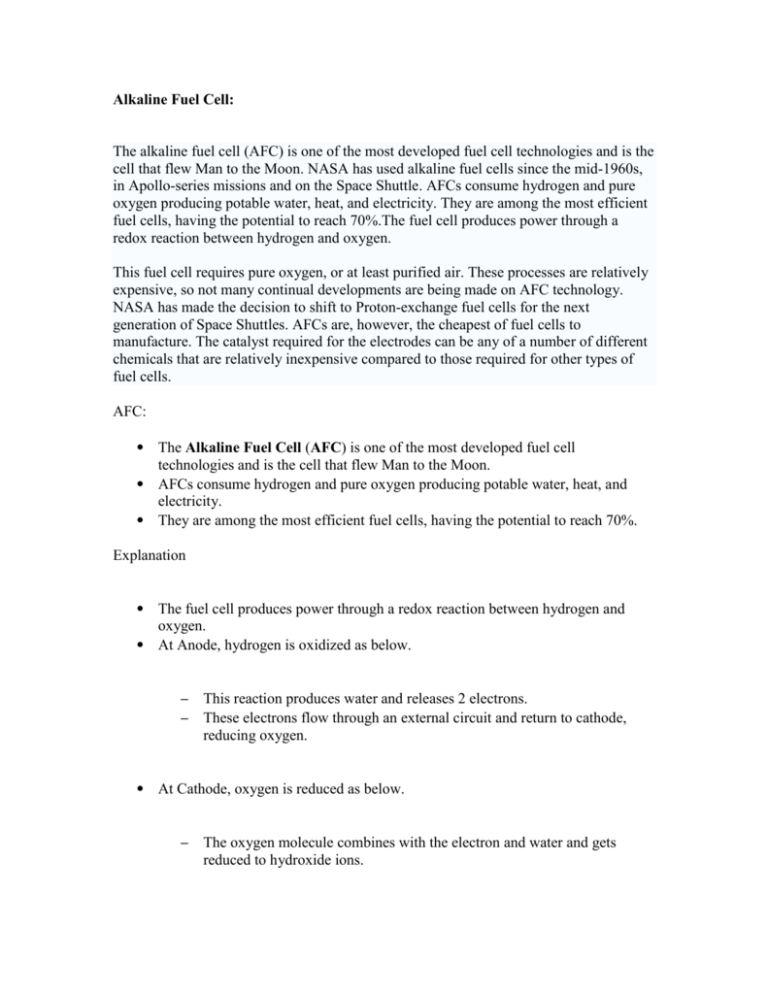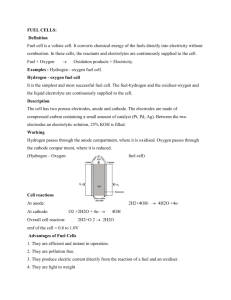Alkaline Fuel Cell:
advertisement

Alkaline Fuel Cell: The alkaline fuel cell (AFC) is one of the most developed fuel cell technologies and is the cell that flew Man to the Moon. NASA has used alkaline fuel cells since the mid-1960s, in Apollo-series missions and on the Space Shuttle. AFCs consume hydrogen and pure oxygen producing potable water, heat, and electricity. They are among the most efficient fuel cells, having the potential to reach 70%.The fuel cell produces power through a redox reaction between hydrogen and oxygen. This fuel cell requires pure oxygen, or at least purified air. These processes are relatively expensive, so not many continual developments are being made on AFC technology. NASA has made the decision to shift to Proton-exchange fuel cells for the next generation of Space Shuttles. AFCs are, however, the cheapest of fuel cells to manufacture. The catalyst required for the electrodes can be any of a number of different chemicals that are relatively inexpensive compared to those required for other types of fuel cells. AFC: • The Alkaline Fuel Cell (AFC) is one of the most developed fuel cell technologies and is the cell that flew Man to the Moon. • AFCs consume hydrogen and pure oxygen producing potable water, heat, and electricity. • They are among the most efficient fuel cells, having the potential to reach 70%. Explanation • The fuel cell produces power through a redox reaction between hydrogen and oxygen. • At Anode, hydrogen is oxidized as below. – – This reaction produces water and releases 2 electrons. These electrons flow through an external circuit and return to cathode, reducing oxygen. • At Cathode, oxygen is reduced as below. – The oxygen molecule combines with the electron and water and gets reduced to hydroxide ions. • The net reaction consumes one oxygen molecule and two hydrogen molecules in the production of two water molecules. Electricity and heat are formed as byproducts of this reaction. Complete Reaction Equations Anode Reaction: 2 H2 + 4 OH- => 4 H2O + 4 e- Cathode reaction: O2 + 2 H2O + 4 e- => 4 OH- Overall Net Reaction: 2 H2 + O2 => 2 H2O Operating Conditions • Alkaline fuel cells use an electrolyte that is an aqueous (water-based) solution of potassium hydroxide (KOH) retained in a porous stabilized matrix and can use a variety of non-precious metals as a catalyst at the anode and cathode. • The concentration of KOH can be varied with the fuel cell operating temperature, which ranges from 65°C to 220°C (149°F to 428°F). • However, newer AFC designs operate at lower temperatures of roughly 23°C to 70°C (74°F to 158°F). • The charge carrier for an AFC is the hydroxyl ion (OH-) that migrates from the cathode to the anode where they react with hydrogen to produce water and electrons. • Water formed at the anode migrates back to the cathode to regenerate hydroxyl ions. Advantages of AFC • AFCs are the cheapest fuel cells to manufacture. (Reason: The catalyst required for the electrodes can be any of a number of different chemicals that are relatively inexpensive compared to those required for other types of fuel cells). • AFCs' has the highest performance among all types of fuel cells. (Reason: The rate at which chemical reactions take place in the cell is very fast). • Low material costs – plastics, carbon, base metals and metal oxides; no platinum. • Long life span – 2000-plus hours currently. • Superior electrochemical conversion efficiency to other fuel cells and the internal combustion engine. • Quick start, even in sub-freezing temperatures down to minus 40 degrees C. • Simpler heat and water management when compared to other fuel cell technologies. • Like other fuel cells, it is odorless and quiet for enclosed applications Limitations of AFC • AFCs are very sensitive to CO2 that may be present in the fuel or air. – – – The CO2 reacts with the electrolyte, poisoning it rapidly, and severely degrading the fuel cell performance. Therefore, AFCs are limited to closed environments, such as space and undersea vehicles, and must be run on pure hydrogen and oxygen. Furthermore, molecules such as CO, H2O and CH4, which are harmless or even work as fuels to other fuel cells, are poisons to an AFC. • AFC stacks have been shown to maintain sufficiently stable operation for more than 8,000 operating hours. To be economically viable in large-scale utility applications, these fuel cells need to reach operating times exceeding 40,000 hours. ISSUES: • AFCs are not being considered for automobile applications. Their sensitivity to poisoning, which requires use of pure or cleansed hydrogen and oxygen, is an insurmountable obstacle at the present time. (Note: NASA has made the decision to shift to Proton-exchange fuel cells for the next generation of Space Shuttles). • Conversely, AFCs operate at relatively low temperatures and are among the most efficient fuel cells, characteristics that would enable a quick starting power source and high fuel efficiency, respectively. Popular Applications Stationary – such as back up power for communication towers, data centers. Portable – such as prime or auxiliary power for worksites, cottages, boats. Transportation – such as neighborhood electric vehicles, golf cars, fork lift vehicles AFC Applications Deployed • Used by Space Program. • Developed by NASA to power the Gemini Missions and Subsequent Shuttle Operations. Picture of the AFC used in Space Shuttle Present Applications • Fuel Cell Taxi & Boat http://www.infotools.hfpeurope.org/energyinfos__e/fuelcells/main06.html • Generator and Golf Car http://www.astris.ca/PR/PR50.php Future Developments - ALKANLINE FUEL CELL – TECHNOLOGY FOR THE 21st CENTURY • Alkaline cells, just like alkaline based batteries, are reliable performers that can be built inexpensively from down-to-earth materials – carbon, plastic, base metals; they use cheap electrolyte, start instantly and perform even in deep subzero temperatures. They do not depend on expensive platinum catalyst. And one of the alkaline cell problems often quoted by their detractors – their limited tolerance to carbon dioxide – has been solved by engineers many times over. • The complete article is in a PDF format and its uploaded in directory “MURU” under the name “AFC-Future.PDF”. • What is the electrolyte used in AFC? – NaOH – KOH – LiOH – Ca(OH)2 • How much operating hours should any fuel cell posses to be economically viable in large-scale utility applications? – > 8000 Hours – Between 8000 Hours & 40,000 Hours – < 40,000 Hours – > 40,000 Hours • What makes AFCs cheaper to manufacture? – Due to inexpensive cathode. – Due to inexpensive anode. – Due to lesser working temperature conditions. – Due to inexpensive electrolyte. • Which fuel cell is being replaced for AFCs in the next generation space shuttles? – Phosphoric Acid Fuel Cell. – Solid Oxide Fuel Cell. – Proton Exchange Fuel Cell. – Molten Carbonate Fuel Cell.







